Artist Name
You can click on the medals to see the reverse.
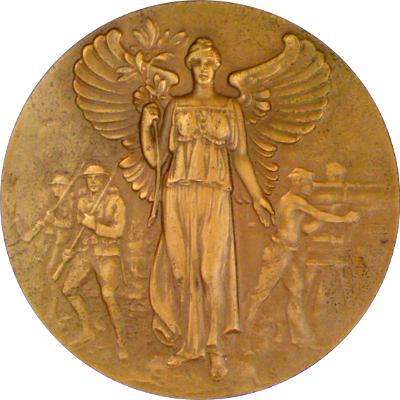
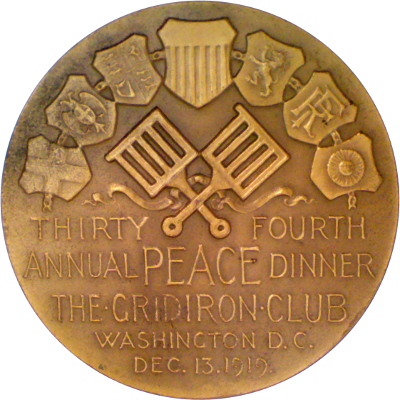
The obverse bears angel of peace (or victory) in center, U.S. infantrymen to left, navy gunner to right. Signed at lower right, S.
The reverse bears heraldic symbols of the victorios Entente nations above Gridiron Club symbol. Below, THIRTY - FOURTH / ANNUAL PEACE DINNER / THE GRIDIRON CLUB / WASHINGTON D.C. / DEC. 13. 1919.
The Gridiron Club, founded in 1885, is the oldest journalistic organization in Washington, D.C. The club is best known for its annual dinner which traditionally features the United States Marine Band, along with satirical musical skits by the members and remarks by the President of the United States and representatives of each political party. The skits and speeches by various politicians are expected to be self-deprecating or otherwise sharply comedic. Since its inception, every President except Grover Cleveland has spoken at the dinner.
The thirtyfourth annual dinner held on December 13, 1919 was called the "Peace Dinner" to celebrate the end of World War I and the beginning of a long lasting peace after "the war to end all wars" had come to an end. Woodrow Wilson used his speech to thank the nation for its efforts and to chart out the future of international relations.
The medal measures 70mm in diameter and was struck by the U.S. Mint.
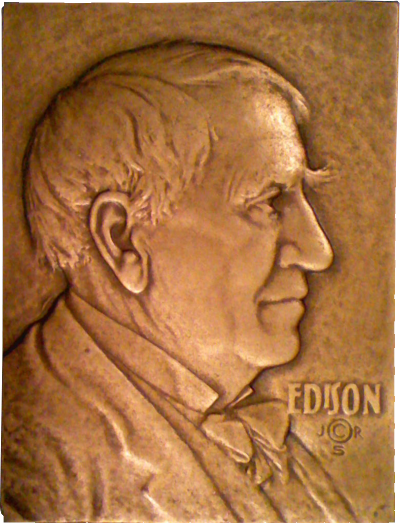
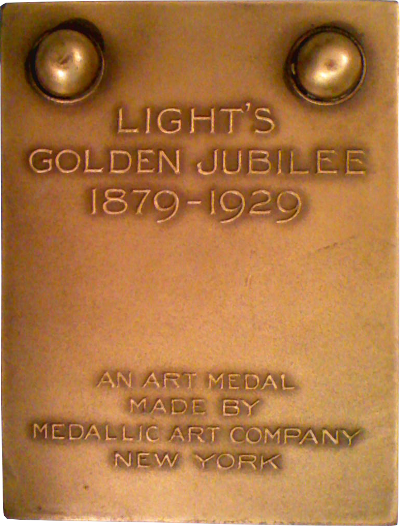
The obverse bears bust of Edison facing right. On right side, EDISON; signed with Sinnock's monogram J © R / S
The reverse bears the legend LIGHT'S / GOLDEN JUBILEE / 1879 - 1929 / AN ART MEDAL / MADE BY / MEDALLIC ART COMPANY / NEW YORK
Light's Golden Jubilee was a celebration of the 50th anniversary of Thomas Edison's incandescent light bulb, held on October 21, 1929, just days before the stock market crash of 1929 that swept the United States headlong into the Great Depression. The Jubilee also served as the dedication of Henry Ford's Greenfield Village, originally known as the Thomas Edison Institute.
The plaque measures 58mm x 77mm and was struck in bronze by the Medallic Art Company of New York.
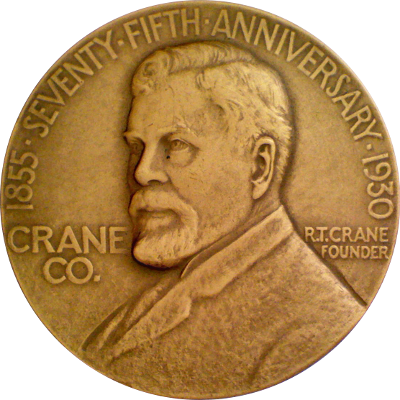
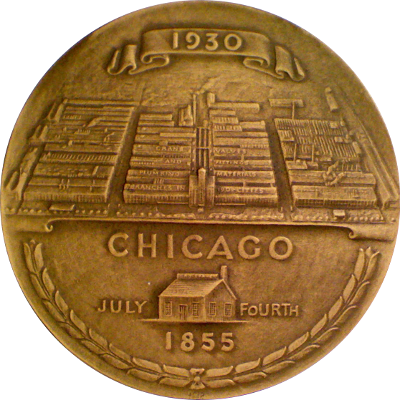
The obverse bears bust of Richard T. Crane facing left, surrounded by 1855 · SEVENTY · FIFTH · ANNIVERSARY · 1830 with CRANE / CO. in field to left and R.T.CRANE / FOUNDER to right.
The reverse bears a banner with 1930 above an large factory in the upper half, CHICAGO in the center with a small factory building below, JULY / FOURTH to left and right and 1855 below, signed J © S at the bottom edge.
This medal measures 63mm in diameter and was struck by the Medallic Art Company of New York.
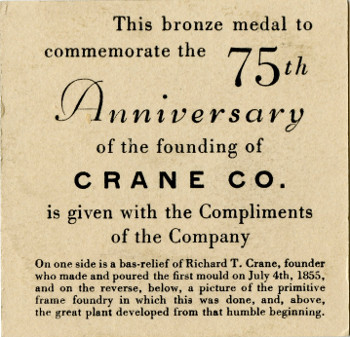
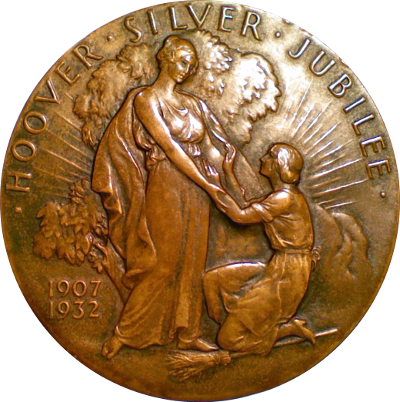
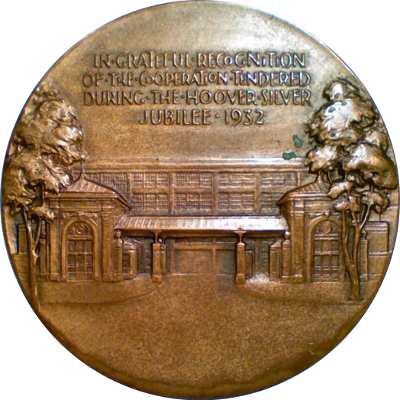
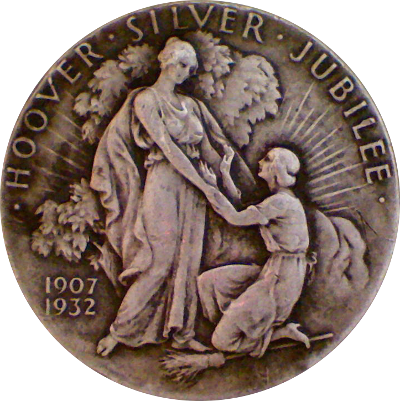
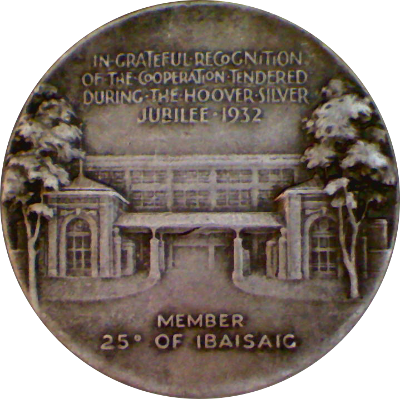
The obverse bears kneeling woman with old-fashioned broom beneath her being raised by goddess; trees and sun in background. Above, HOOVER SILVER JUBILEE; at lower left, 1907 / 1932.
The reverse bears image of Hoover's factory. Above, IN GRATEFUL RECOGNITION / OF THE COOPERATION TENDERED / DURING THE HOOVER SILVER / JUBILEE 1932; Small silver has dedication below, MEMBER / 25 (circle) OF IBAISAIC.
The token has the following maker's mark at 6:00: MEDALLIC ART CO NY SILVER
IBAISAIC stands for "It beats... as it sweeps... as it cleans," the Hoover Company's advertising slogan invented by Gerald Page-Wood, an art director of Erwin, Wasey & Company, in 1919. The slogan referred to the action of revolving brushes that vibrated the carpet to loosen trodden-in dirt and provied early Hoover vacuum cleaners a distinct advantage over competitors' models.
This medal's obverse design was picked up again one year later. Hoover exhibited at the Chicago Worlds Fair in 1933 and handed out bronze tokens to visitors of the Hoover Exhibit.
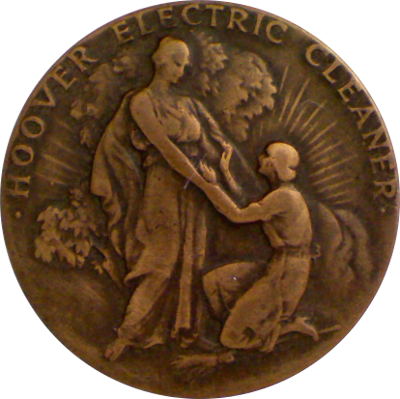

The obverse bears kneeling woman with old-fashioned broom beneath her being raised by goddess; trees and sun in background. Above, HOOVER ELECTRIC CLEANER
The reverse bears image of Chicago fair grounds. Above, CENTURY / OF PROGRESS / 1933; below, SOUVENIR OF THE / HOOVER / EXHIBIT
The Hoover Company was founded as a floor care manufacturer in North Canton, Ohio, in 1908. It so completely dominated the electric vacuum cleaner market in the first half of the 20th century that "hoovering" became synonymous with vacuum cleaning, much as "googling" became synonymous with web searching at the beginning of the 21st century.
This is such a handsome token, and also one whose imagery is so completely over the top! I would never belittle the impact that the invention of the vaccum cleaner had on a woman cleaning house in the 1930s, but I always have to smile at the woman's look of abject adoration at the prospect of being freed from toil and at the rising sun promising a brighter future.
The token measures 32mm in diameter. It was handed out to visitors of the Hoover Exhibit at the Chicago Cenury of Progress Exhibition of 1933. Its obverse is based on the Hoover Silver Jubilee token from one year earlier.
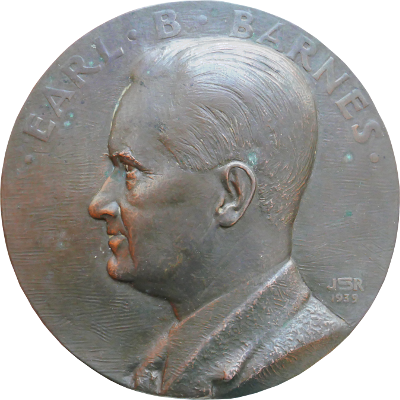
The galvano's obverse bears bust of Earl B. Barnes, a director of Medallic Art Company, facing left. Above, · EARL · B · BARNES ·; signed and dated at lower right, (JSR monogram) / 1935
In the late 1930's, John Curlee Trees, the owner of Medallic Art Company, engaged John R. Sinnock, then working as engraver at the U.S. Mint, to design five portrait medals of MACo's Board of Directors. Medallic Art Company usually created at least one large galvano for each medal they produced. This plaque comes from the family of one of the Directors. Whether all Directors received one or whether this is a unique piece is hard to establish but I'd appreciate hearing from anyone who has another one or can provide additional information.
The galvano plaque measures approximately 305mm (12") in diameter and was produced by the Medallic Art Company of New York.
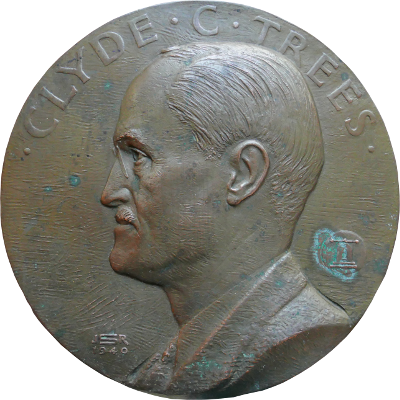
The galvano's obverse bears bust of the owner of Medallic Art Company, Clyde C. Trees, facing left; to his right, medal press in a circle. Above, · CLYDE · C · TREES ·; signed and dated at lower left, (JSR monogram) / 1940
In the late 1930's, John Curlee Trees, the owner of Medallic Art Company, engaged John R. Sinnock, then working as engraver at the U.S. Mint, to design five portrait medals of MACo's Board of Directors. Medallic Art Company usually created at least one large galvano for each medal they produced. This plaque comes from the family of one of the Directors. Whether all Directors received one or whether this is a unique piece is hard to establish but I'd appreciate hearing from anyone who has another one or can provide additional information.
The galvano plaque measures approximately 305mm (12") in diameter and was produced by the Medallic Art Company of New York.
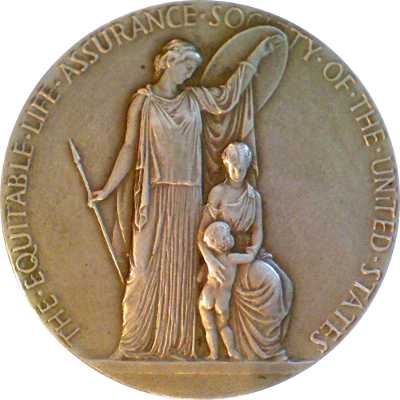
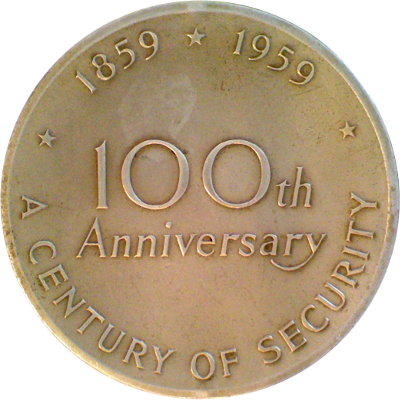
This medal's obverse bears group of three figures, standing, toga-wearing female with spear held in one hand and shield raised protectively over seated mother with naked toddler. Around, THE · EQUITABLE · LIFE · ASSURANCE · SOCIETY · OF · THE · UNITED · STATES
The reverse bears text in center, 100th / Anniversary; around, ★ 1859 ★ 1959 ★ / A CENTURY OF SECURITY
The edge is marked MEDALLIC ART CO. N.Y.; two holes indicate that the medals was once mounted in a desktop holder.
The Equitable Life Assurance Society of the United States was founded by Henry Baldwin Hyde in 1859. Its first headquarters were in the Equitable Life Building, near Wall Street, which opened its doors in 1875. In 1905, James Hazen Hyde, the founder's son and successor as President of the company, found himself at the center of the so called Hyde Costume Ball Scandal, a smear campaign manufactured by other Board members and designed to wrest control of the company from him. The scandal resulted in a Wall Street panic and an investigation of the entire insurance industry. Today, the company is known as AXA Equitable Life Insurance Company.
The medal represents a collaboration by two artists: its artistic obverse was designed and modeled by Sinnock while the text-oriented reverse was done by Roberts.
The circular medal measures 69.9mm in diameter and was struck by the Medallic Art Company of New York.
References: MAco 1958-043-001